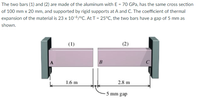
Elements Of Electromagnetics
7th Edition
ISBN: 9780190698614
Author: Sadiku, Matthew N. O.
Publisher: Oxford University Press
expand_more
expand_more
format_list_bulleted
Concept explainers
Question
PLEASE ANSWER ASAP TY!
The two bars (1) and (2) are made of the aluminum with E = 70 GPa, has the same cross section of 100 mm x 20 mm, and supported by rigid supports at A and C. The coefficient of thermal expansion of the material is 23 x 10–6/oC. At T = 25oC, the two bars have a gap of 5 mm as shown.
a) What is the reaction force (in KN) at fixed support A when the temperature is 100oC?
b) What is the reaction force (in KN) at fixed support C when the temperature is 100oC?
c) What is the stress (in MPa) in bar (1) when the temperature is 100oC?
d) What is the stress (in MPa) in bar (2) when the temperature is 100oC?

Transcribed Image Text:The two bars (1) and (2) are made of the aluminum with E = 70 GPa, has the same cross section
of 100 mm x 20 mm, and supported by rigid supports at A and C. The coefficient of thermal
expansion of the material is 23 x 10-6/°C. At T = 25°C, the two bars have a gap of 5 mm as
shown.
(1)
(2)
A
B
C
1.6 m
2.8 m
5 mm gap
Expert Solution
This question has been solved!
Explore an expertly crafted, step-by-step solution for a thorough understanding of key concepts.
Step by stepSolved in 3 steps with 4 images

Knowledge Booster
Learn more about
Need a deep-dive on the concept behind this application? Look no further. Learn more about this topic, mechanical-engineering and related others by exploring similar questions and additional content below.Similar questions
- Thank you. Please help me.arrow_forward2. A core made of stainless steel (material 1, E, = 28 Msi) is fully bonded to an inner shell of brass (material 2, E, = 15 Msi), which is fully bonded to an outer shell of aluminum (material 3, Ea = 10 Msi). The rod is subjected to a compressive load, P = 50 kips. Determine: a) the normal stress in the brass and b) the deflection of the composite rod. Dimensions: L = 10 in, dı = 1 in, d2 = 2 in, d3 = 3 in. Recall that Msi =10° psi. Ans: ob = 7.76 ksi (C), ô = 5.176 x 10-³ in (shorter) 3 2 1 d, d d, - Parrow_forwardPls box ur answer thx uarrow_forward
arrow_back_ios
arrow_forward_ios
Recommended textbooks for you
 Elements Of ElectromagneticsMechanical EngineeringISBN:9780190698614Author:Sadiku, Matthew N. O.Publisher:Oxford University Press
Elements Of ElectromagneticsMechanical EngineeringISBN:9780190698614Author:Sadiku, Matthew N. O.Publisher:Oxford University Press Mechanics of Materials (10th Edition)Mechanical EngineeringISBN:9780134319650Author:Russell C. HibbelerPublisher:PEARSON
Mechanics of Materials (10th Edition)Mechanical EngineeringISBN:9780134319650Author:Russell C. HibbelerPublisher:PEARSON Thermodynamics: An Engineering ApproachMechanical EngineeringISBN:9781259822674Author:Yunus A. Cengel Dr., Michael A. BolesPublisher:McGraw-Hill Education
Thermodynamics: An Engineering ApproachMechanical EngineeringISBN:9781259822674Author:Yunus A. Cengel Dr., Michael A. BolesPublisher:McGraw-Hill Education Control Systems EngineeringMechanical EngineeringISBN:9781118170519Author:Norman S. NisePublisher:WILEY
Control Systems EngineeringMechanical EngineeringISBN:9781118170519Author:Norman S. NisePublisher:WILEY Mechanics of Materials (MindTap Course List)Mechanical EngineeringISBN:9781337093347Author:Barry J. Goodno, James M. GerePublisher:Cengage Learning
Mechanics of Materials (MindTap Course List)Mechanical EngineeringISBN:9781337093347Author:Barry J. Goodno, James M. GerePublisher:Cengage Learning Engineering Mechanics: StaticsMechanical EngineeringISBN:9781118807330Author:James L. Meriam, L. G. Kraige, J. N. BoltonPublisher:WILEY
Engineering Mechanics: StaticsMechanical EngineeringISBN:9781118807330Author:James L. Meriam, L. G. Kraige, J. N. BoltonPublisher:WILEY

Elements Of Electromagnetics
Mechanical Engineering
ISBN:9780190698614
Author:Sadiku, Matthew N. O.
Publisher:Oxford University Press

Mechanics of Materials (10th Edition)
Mechanical Engineering
ISBN:9780134319650
Author:Russell C. Hibbeler
Publisher:PEARSON

Thermodynamics: An Engineering Approach
Mechanical Engineering
ISBN:9781259822674
Author:Yunus A. Cengel Dr., Michael A. Boles
Publisher:McGraw-Hill Education

Control Systems Engineering
Mechanical Engineering
ISBN:9781118170519
Author:Norman S. Nise
Publisher:WILEY

Mechanics of Materials (MindTap Course List)
Mechanical Engineering
ISBN:9781337093347
Author:Barry J. Goodno, James M. Gere
Publisher:Cengage Learning

Engineering Mechanics: Statics
Mechanical Engineering
ISBN:9781118807330
Author:James L. Meriam, L. G. Kraige, J. N. Bolton
Publisher:WILEY